Listen to the radio version here.)
Over my adult life, I’ve been involved in a lot of controversial issues. I’ve been insulted, ridiculed, demeaned, and physically threatened when I spoke up at public forums about such issues as the threats to migratory birds of proposed communications towers and shoreline development projects, a proposed cat leash ordinance in Duluth, my wanting to limit a proposed Mourning Dove hunting season in Minnesota to non-lead shot, and begging the Minnesota DNR to not open a hunting season on Sandhill Cranes. (They opened the annual hunting season in 2010, yet continue, even this year, to use the Sandhill Crane as an example of why we should donate to the Nongame Wildlife Program.)
But of all the critical comments, calls, letters, and emails I’ve received since I started producing For the Birds 38 years ago, never have I stirred up as much anger and vitriol as I did last week, when a stranger found a 2007 blogpost I wrote about feeding jelly to birds and sent me an email with the subject line, “You're wrong and offensive.” The email read, in its entirety (except I’ve changed two vowels to asterisks):
You're full of sh*t about feeding jelly to birds, and for the record, food addiction is a HUGE problem in America and added sugar is killing us. Typical Midwest suburban mom arrogance. F*ck you.
In everything I’ve ever written about giving birds jelly, I’ve discussed, usually with a very graphic photo, how dangerously sticky jelly is, and why we must only offer it in small amounts.
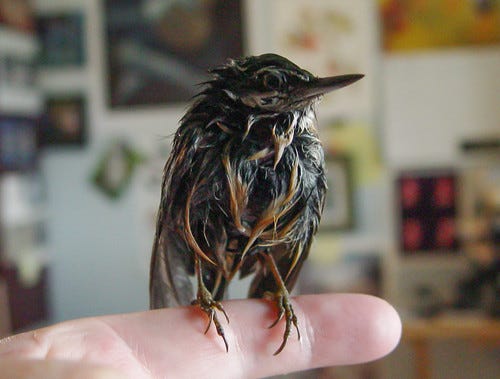
Last year, I wrote a new blog post cautioning people about how rehab clinics are suddenly admitting hummingbirds covered in jelly, and edited that old 2007 post to add a caution and link to my new post about the potentially fatal hazards involved in feeding this sticky substance to birds.
The only food we should ever offer wild hummingbirds (besides, of course, planting locally-native pollinator plants) is sugar water. Simply mix a quarter cup of granulated sugar per cup of water. During cold periods, especially cold and rainy periods during migration when the hummingbirds need more calories, I make it a third of a cup of sugar per cup of water, which is at the upper limit of the sugar content of natural nectars. Never ever add food coloring!
Bird feeding stores sell hummingbird “nectar” that’s usually been laced with red food dyes despite several studies and lots of carefully observed anecdotal information that it’s harmful to hummingbirds as well as completely unnecessary; flower nectar is clear, and hummingbirds are attracted to our feeders by their color and style, not the color of the sugar water inside it.
Commercial hummingbird mixes also have other additives, completely unnecessary and quite possibly harmful. Wild hummingbirds get enough protein from insects even when it’s cold outside to not need any supplements. (In November and December in both 2004 and 2021, I watched a Rufous Hummingbird darting for insects in my own trees and herbaceous plants even on very cold days, as well as visiting my feeders.)
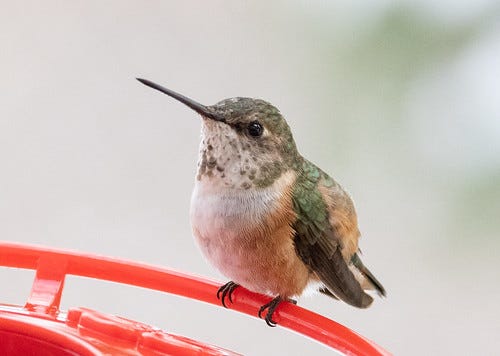
I have no idea where anyone got the idea to “liquify” jelly for hummingbirds. The thickening agents in jelly, which remain even when it’s diluted, have no nutritional value, and liquified jelly is thicker than nectar, so utterly inappropriate for hummingbirds. REGI (a world class rehab center in Antigo, Wisconsin) has been brought hummingbirds whose plumage had been entirely gooped up after visiting jelly or liquified jelly feeders. Without professional help, these birds were doomed. Hummingbirds should NEVER be fed jelly in any form, period.
Way too many people tell me, with delight, that they’re seeing orioles bringing their fledglings to jelly feeders when those growing birds desperately need protein, not carbohydrates—I’ve warned against that for over three decades. Sugary foods also foster bacterial growth, especially in warm weather. There is no justification for using jelly for any birds in summer. At the very latest, by the time ants and bees are visiting, it’s time to stop offering jelly for the year.
So why offer it at all, even during cold periods in spring? The danger of jelly for adult birds lies in its stickiness, not its nutritional value for physically taxed migrating birds desperate for carbs. When a bird weighing less than an ounce flies several hundred miles overnight, its body can incredibly stressed, and it needs calories immediately. Here in the upper Midwest, temperatures hover near or below freezing on many mornings during the height of spring migration, before the first blossoms open or many insects are available. That’s when birds gravitate to jelly. During the springs when I’ve had the most birds visiting my jelly feeders, other birders and I have found dead warblers, tanagers, and orioles in the woods, no wounds or other obvious signs of cause of death except severe emaciation.
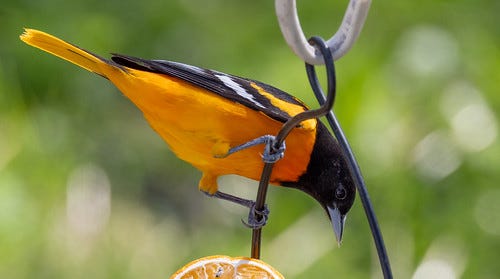
Ever since I first started getting emails over the years (mostly polite and never abusive) telling me that jelly has no food value for birds, I’ve shared the comments on my blog because I could be wrong. (I hardly ever share comments praising or supporting my work, though I’ve heard from quite a few people who liked my nuanced stance about feeding jelly.) I’ve also publicly and repeatedly asked for scientific data OR anecdotes suggesting that wild migrating birds can be harmed nutritionally from jelly. I’m still waiting, but people have sent me lots of anecdotal information that it’s not harmful, including sightings of banded individual orioles and warblers returning for several years running to someone’s jelly feeders during spring migration.
Obviously, that is not proof that jelly is nutritionally sound, and we have plenty of evidence that it’s bad for nestlings and fledglings, but I’ve yet to see a single shred of evidence that sugar-based jelly presents a nutritional danger to wild migrating songbirds.
The danger of jelly for adult birds lies in its stickiness, not its nutritional value for physically taxed migrating birds.
Only one critic has ever contacted me citing an expert on birds who told her that jelly was inappropriate for feeding birds. She said that the primary caretaker for many kinds of birds at the San Diego Wild Animal Park said that jams and jellies are more than half sugar—much higher than the sugar content of nectar and natural fruits—and that products high in sugar quickly develop bacterial growth.
When I was rehabbing birds, I never offered jelly to captive birds either. The birds in my care depended on me for a balanced diet, and jelly isn’t part of that for sedentary patients. I provided the injured birds in my care natural fruits and plenty of mealworms, crickets, and other high-protein food.
And as he noted, bacterial growth is an important issue, indoors at any season and outdoors during warm and hot weather, something someone in San Diego would know a lot about. But I’m in northern Minnesota, and I’ve always cautioned people about keeping feeders clean and the food fresh. Many people tell me grapes are much better than jelly, but of all the fruits I’ve ever kept in my refrigerator or on the counter, grapes are the fastest to get moldy. I’ve seen mold on grapes fresh from the store within 24 hours of setting them outside, even during cold weather.
All the other information people have given me suggesting that jelly is nutritionally dangerous comes from human studies, which are simply not applicable to birds. I’ve taken college classes in both human and avian physiology (just entry level—I’m no expert), but I learned for certain that wild bird bodies function entirely differently from ours with regard to metabolism, fat deposition, and the enormous capacity for gaining and losing weight during migration.
One writer consulted an internist (a human doctor) who said that foods high in sugar may trigger a bird's “satiety gland” (I’m assuming he was referring to the hypothalamus) much as they do in children, causing the bird to feel satisfied when it has had little in the way of nutritional value. But hunger and satiety sensations in migratory birds are entirely different from those in human children. Before any migratory flight, birds must pig out and lay on as much fat as possible without feeling too full; once they take off, they must not stop flying until they reach land no matter how hungry they get; and after an an exhausting migratory flight, they must grab as many calories as possible to replenish their bodies.
Every migrating bird appearing at our feeders this spring will be at least one year old on its upcoming birthday (well, its hatchday) in late spring or early summer. That means that the Scarlet Tanagers I’m seeing have all survived at least one round trip from the north woods to South America and back again—a minimum of about 3,000 miles and as much as 4,600 miles EACH WAY—and many or most of my birds must be older than one year old. (Based on banding studies, wild Scarlet Tanagers have been known to survive longer than a decade.)
That letter writer’s internist suggested that sugar may be addictive for birds as it can be in humans, and that a bird might develop a strong liking for jelly and spend less time searching for natural foods. Ever since reading that, I’ve spent a lot of time tracking the birds eating jelly in my own yard. Many of them fly off instantly without allowing me to see where they go, but I’ve watched dozens of Cape May Warblers and several Scarlet Tanagers head to nearby trees where I could see them picking insects from early catkins and flower parts, or at the tips of spruce branches. And I’ve never seen any bird spend more than a minute or two at a jelly feeder before flying off. Yes, they return, but even on the coldest, windiest, rainiest days, my feeders have never been their primary food source.
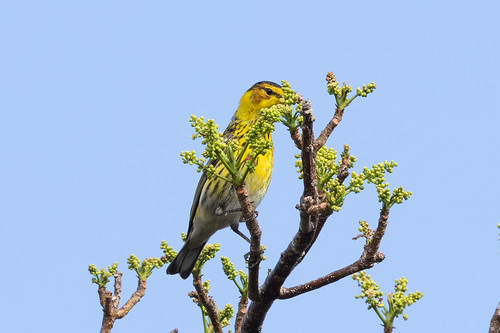
I never saw birds feed more voraciously at jelly than I did in the spring of 2022, when May was unusually cold even for up here. I sometimes had more than a dozen Cape May and Tennessee Warblers gathered at the feeders, but I could walk around my yard and my neighborhood to see many dozens more feeding on natural fare in the trees. Even at their most desperate, these wild migrating birds were using jelly as a supplement, not their entire diet.
I’ve also paid attention to what individual birds take at my feeders. Gray Catbirds, Baltimore Orioles, and Cape May Warblers feed on suet, oranges, and jelly but seem to have a slight preference for jelly. Yellow-rumped Warblers have a clear preference for suet but I’ve seen them occasionally at both oranges and jelly. This year I had an unprecedented six Scarlet Tanagers coming to my feeders. They seem to have a strong preference for oranges and suet over jelly, though they did take jelly, too. (In the 2-minute uncut video below, you can see two different males eating in my window feeder. Both bowls contain orange pieces with a small plop of jelly in the center. The first bird seems focused on the jelly, but the second seems to be eating only from the oranges.)
This morning, Sunday, at 5 am the temperature was 47º F, and by 7 o’clock it had risen to the upper 50s. Instead of the half dozen tanagers I had yesterday, I’ve had just one at the feeder, though at this very moment I can see at least three in the trees in the back of my yard. I had dozens of Cape May and Yellow-rumped Warblers for a couple of weeks, but both species disappeared entirely by yesterday. These wild migratory birds are clearly not dependent on or addicted to jelly.
Today the temperature is expected to reach the 70s, so I’ll be taking in the jelly this morning. I may set some out on Tuesday when it’s supposed to be cold, windy, and rainy, but when that clears out, it’ll probably be time to bring in the jelly for the year.
Being a mother and now a grandmother, I am of course alarmed by the rise of childhood obesity and addiction, even as those issues have nothing at all to do with feeding wild birds. But I simply cannot wrap my head around how this issue, more than any other controversial subject I’ve tackled over the past 45 years of my writing career, has been the one to spark such an obscenity-laced email. I know I can’t please all, or even most, of my readers with anything I write. But whoa!



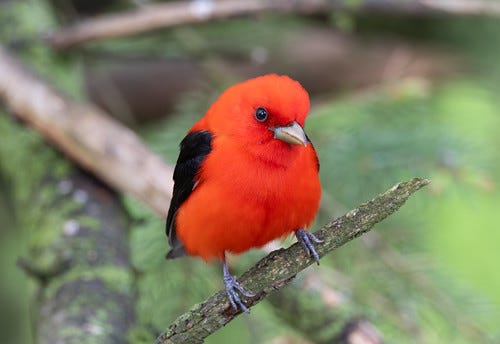
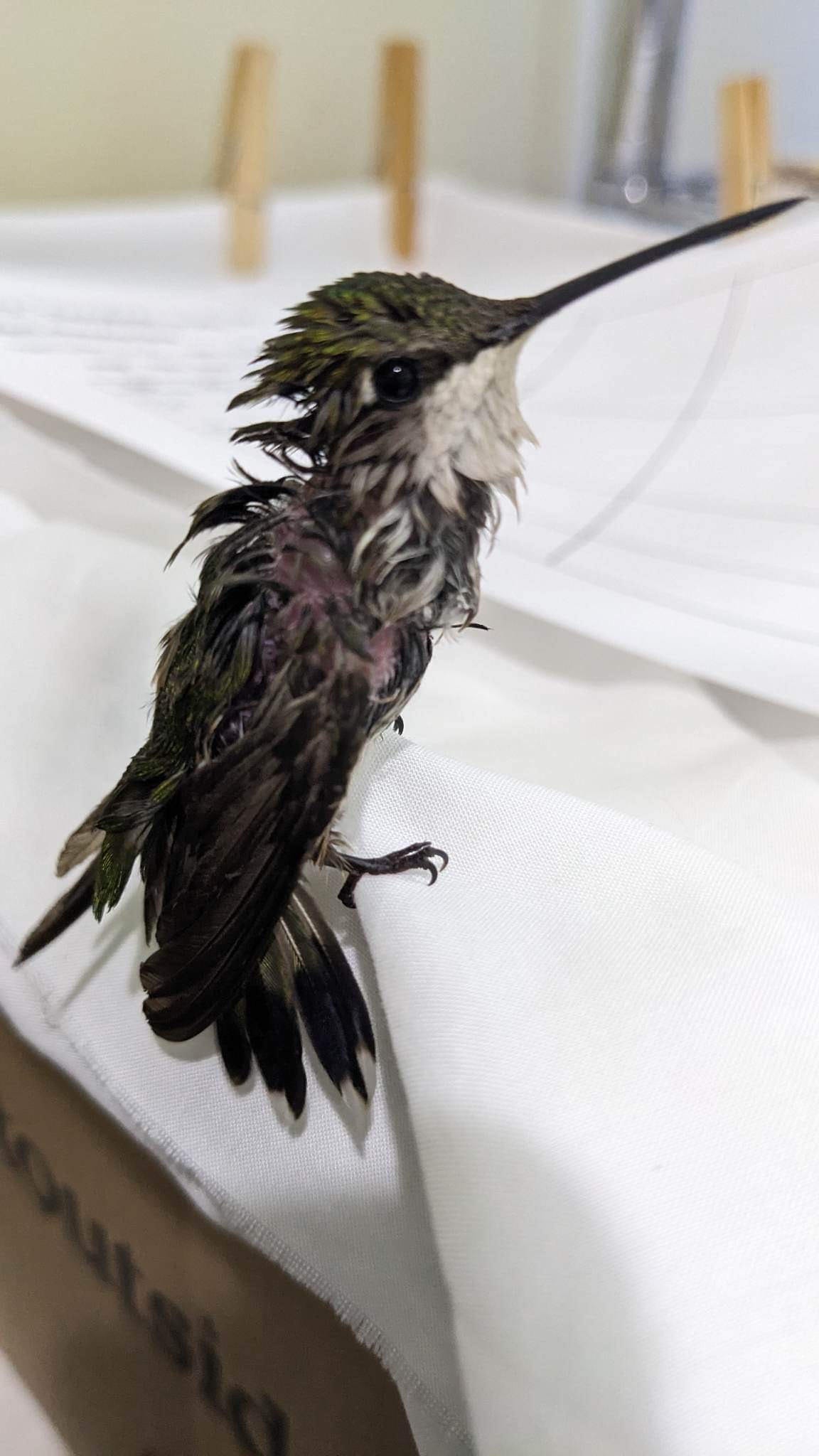
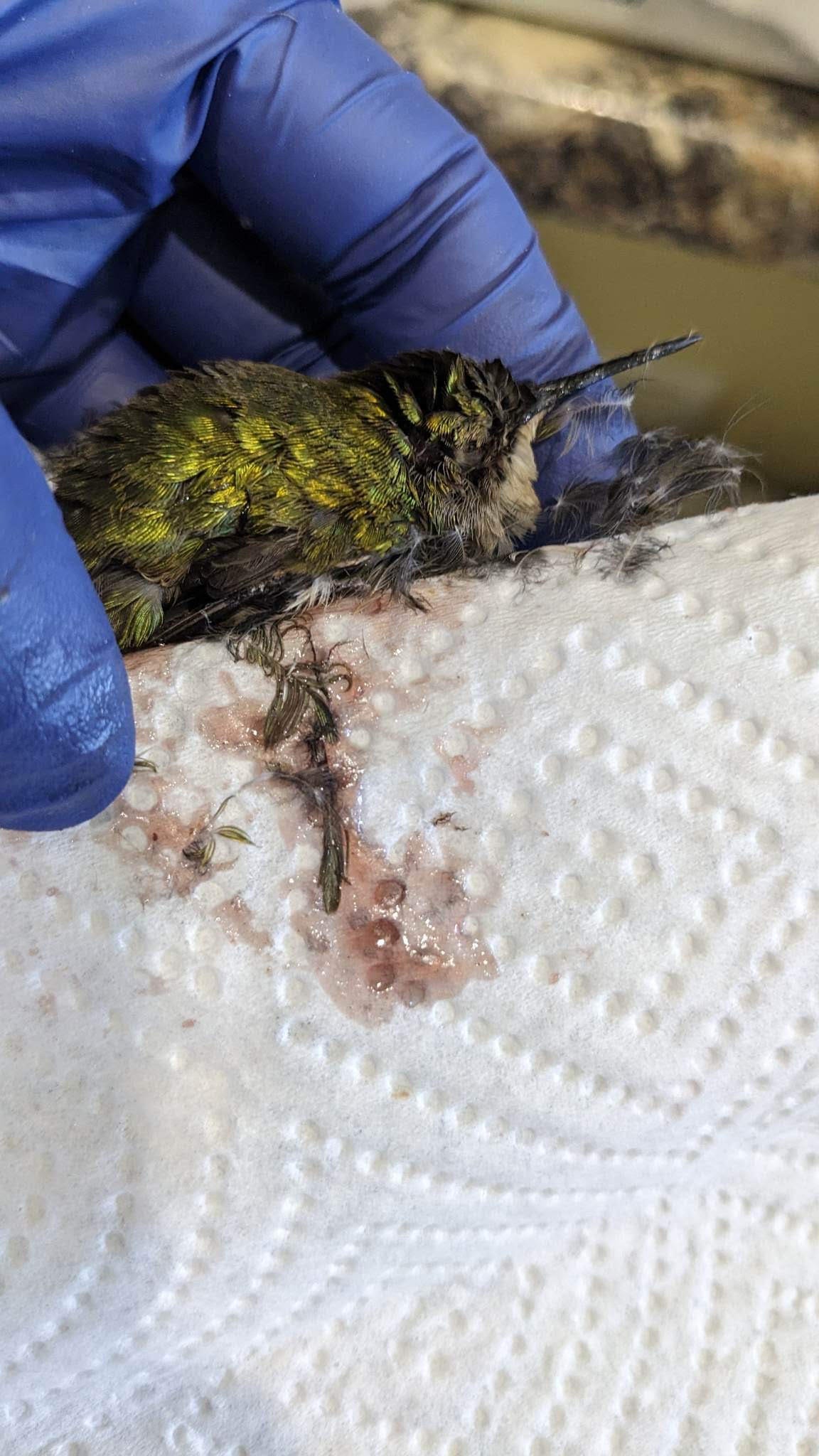
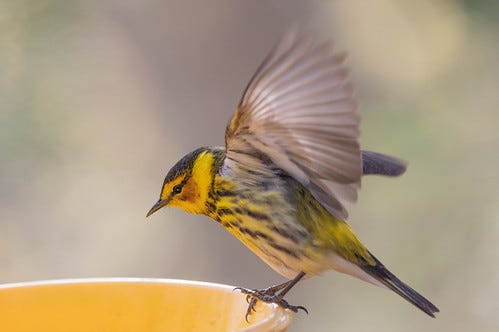
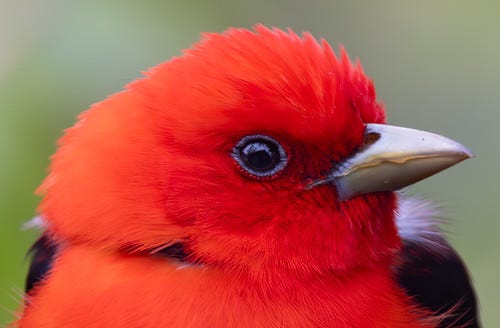
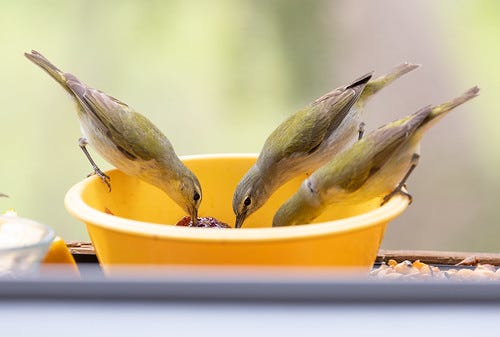
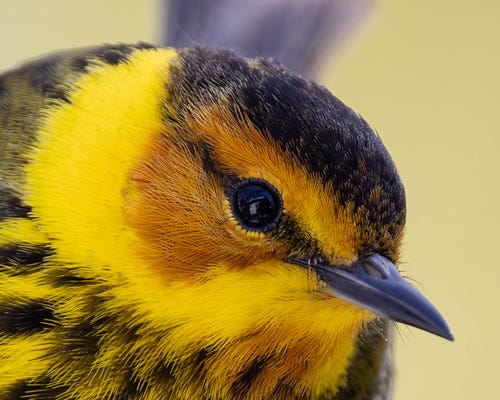
I so appreciate your alerting us to the jelly situation and encouraging us to follow you as you learn more about the right way to use jelly and to which birds!
I so appreciate your column and comments. I too have experienced the strong feelings of readers on a variety of topics. The better part of me excuses them for having a bad day or challenging personality, but then there is the me that is confused and hurt. I know your intentions are absolutely pure. I never doubt that as do your followers. I am so grateful for you and your writing. 🤗❤️😇